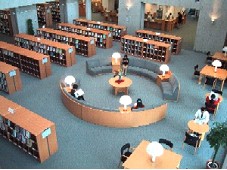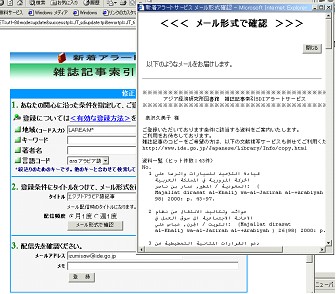| 04/08/11 | |||||||||||||||||||||||||||||||||||||||||||||||||||||||||||||||||
| The Library of the Institute of Developing Economies, Japan External Trade Organization (IDE-JETRO) | |||||||||||||||||||||||||||||||||||||||||||||||||||||||||||||||||
| @@ | |||||||||||||||||||||||||||||||||||||||||||||||||||||||||||||||||
| Kumiko Izumisawa | |||||||||||||||||||||||||||||||||||||||||||||||||||||||||||||||||
| (Director,@Planning and Coordination Division, Library) | |||||||||||||||||||||||||||||||||||||||||||||||||||||||||||||||||
After moving out of Ichigaya in the center of Tokyo in November 1999, to our present location in Makuhari, Chiba City, one of the new metropolitan centers, the IDE Library today offers a comfortable space in a four-story building, with a million volumes of materials in open stacks and equipped with 100 seats for reading. When the Library was in Ichigaya, there was not enough space in the book stacks to hold the massive materials of half a million volumes, and part of the holdings therefore had to be kept in external storage. Today, the Library, with its extensive space, is far more user-friendly. Even staff members who have been with the Library for a long time sometimes gdiscoverh valuable books that have been overlooked for years, and are impressed afresh by the wonderful qualities of the collection accumulated over 40 years or more. Such moving experiences is primarily made possible by the new environment. However, to people who take it for granted that everything should be in Tokyo, Makuhari seems to be an gextremely remote and inconvenient place.h We urge such people to visit the Library at least once. We are confident that they will find the Library extremely stimulating, and that it will enhance their motivation toward research. In the following, I would like to give some PR for the Library, describing its unique collections and inviting you to visit our IDE Library. For details, please see the official website of the Library.
Comprehensive statistical yearbooks, censuses on population, industries, agriculture, etc. and individual statistics on manufacturing, trade, social issues, finance and government finance are mostly purchased directly or collected on an exchange basis from the departments of statistics and/or central banks of the respective countries. There are cases where the Library does not have statistics. For example, it is extremely difficult to find access to publications in countries such as the Central African Republic, and for some countries we cannot obtain copies because the print runs are too small. However, as a whole the Library has quite a substantial collection of statistical yearbooks from developing countries published since the beginning of the 20th century, including all the issues of gThai Statistical Yearbookh first published in 1916, and gEgypt Statistical Yearbook,h first published in 1909, obtained later in microfilm. We also have an enormous volume of censuses published by Indiafs central and regional statistical bureaus. Recent acquisition include 1,000 volumes of Iranian censuses from the 1990s, including the population census in 1996, nomad census in 1998, and industrial census. It is very likely that we are the only library in Japan with these holdings. @
At present, the latest editions of newspapers can be read on the Internet. The Internet versions provide the news faster, yet the printed editions are superior in the sense that one can read the editions from many days at once in accordance with onefs own needs and convenience. Also, when conducting retrospective research on political, economic and social conditions in a certain locality, back numbers of newspapers can be truly valuable resources. Starting in September, when Japanese students begin to devote themselves to their graduation theses, the Library has many visitors asking for newspapers on microfilm. The three microreaders available in the Library are fully occupied most of the time. Among the newspapers, those from China and South East Asia are very popular. The Library also has a relatively good collection of newspapers from the Middle East, Latin America and Africa. In March 2003, the following newspapers were purchased in microfilm.
@Official gazettes, mainly from South East Asian countries, are collected on an ongoing basis. Among them, the collections from Thailand, the Philippines, Malaysia, Brunei, Singapore, Indonesia and Vietnam are comprehensive. They include the gKingdom of Thailand Official Gazette,h which the Library holds starting from volume 2 in 1865 (missing 1934-58). The Library also has original versions of the gofficial gazwtteh published by the official gazette publication office of the newly born Republic of Korea, following its liberalization from colonization, from the very first issue of September 1, 1948 to No.7359 of May 31, 1976. Even in South Korea, the country of origin, it is impossible to find complete sets due to the effects of the Korean War. The National Diet Library and our library seem to be the only institutions that possess complete sets of the publication. Recently, a CD-ROM version was published (by Suzusawa Shoten), making use of the original gazettes held by the IDE library. In addition to Asian gazettes, gazettes of Egypt (1955-69: some issues missing), Saudi Arabia (1924-60), Chile (1966-1993) and others are available.
@The Library receives approximately 1,400 periodical titles on an ongoing basis, including area study journals from the West. They include many weekly magazines in vernacular languages, which can rapidly communicate news of communities in their respective localities, as well as many in-house journals of research institutions. Quite a few of these periodicals are not handled by Japanese distributors, and therefore the IDE Library obtains them either directly from the publishers or on an exchange basis. As is also the case with newspapers, direct dealings with local publishers have never been trouble free, and inevitably cause headaches for librarians. This method is only made possible by the strenuous efforts made by the IDE Library since its foundation to develop and maintain access routes to local publications. @B
Another new acquisition, gAtlas of the Near and Middle East: History, geography & cultural anthropology (TAVO)h is made up of over 200 historical, ethnic distribution, archaeology and Palestine-related maps, and is very valuable for Middle East researchers. A map copying service is also available.
Books written in vernacular languages are arranged in stacks by language. Collections with over a thousand volumes include Chinese (approximately 25,000 volumes), Korean (approx. 15,000), Arabic (approx. 5,000), Indonesian (approx. 3,700), Thai (approx. 3,000) and Vietnamese (approx. 1,600). There are many valuable books that can be found only in our Library. Of course, these collections need to be further improved. @
(1) Allows multilingual searches (in Chinese, Korean, Arabic, Thai and other non-Roman letters) (2) Combined searches can be done of books and periodicals as well as the Periodical Article Index developed by the IDE Library. (3) Searches can be limited by a gregional codeh unique to the IDE Library. The gPeriodical Article Indexh is an index of articles in Japanese and foreign journals devoted to developing countries that has been maintained by the Library since the very beginning. The databases have been developed since 1986, and currently include approximately 220,000 entries. The gregional codeh is a four-letter code created by the Library for internal use to limit searches of materials concerning a certain area and a country, such as Asia or China. For example, gAECCh is the code for China. The first digit (A) indicates Asia, a large region; the first two digits (AE) signify East Asia, an intermediate region; and the third and fourth digits (CC) indicate China. A search can be performed simultaneously of a major region and intermediate region, or of a specific country. In addition, once a region is designated, a sub-search by subject can be performed using headings such as politics and economy. It may be that far more people use the NACSIS Webcat rather than individual libraryfs OPAC online catalogs. However, only about 120,000 of the roughly 300,000 books in our Library can be searched using Webcat. From various reasons, statistical data and books in the political and economic fields in the 1990s or earlier are not entered. Using our own OPAC, you can search about 230,000 books, including statistical data in our collection, and it is really preferable to use our OPAC. Today, it is taken for granted that libraries have online catalogs. Our target is to develop, within a few years, databases of all the materials in our holdings except for those in rare writing systems. By the end of FY2004, data entry for Korean and Arabic books will be completed. This will be followed by the entry of the data on Chinese books and also by work to correct the statistical data, which are not easy to search.
@I would next like to draw your attention to our gNew arrival alert service ,h a very useful service which was launched in July 2003.
Users, by using the Internet to simply register the region(s) and items of interest to them, can receive regular e-mails providing information on new arrivals that match their interest. This service is great for people who want to keep a close eye on resources in a specific field. Three services are available -- (1) Book SDI alert, (2) Periodical Article Index SDI alert, and (3) latest issue alert (covering about 55,000 magazine titles). As of the end of July 2004, about 420 users are making use of this service. Needless to say, our objective for introducing this service is to attract new visitors to the Library. However, a questionnaire survey we carried out showed that many users apparently borrow materials from other libraries after obtaining information through our alert service. Well, no matter what library users may visit to borrow materials from, we still remain passionate about disseminating newly arrived information on developing countries to as many people as possible. When you receive information on materials via e-mail, you can borrow them from the Library, and a copying service is also available for individual users.
|
|||||||||||||||||||||||||||||||||||||||||||||||||||||||||||||||||
|
|
|||||||||||||||||||||||||||||||||||||||||||||||||||||||||||||||||
|
|
|||||||||||||||||||||||||||||||||||||||||||||||||||||||||||||||||


